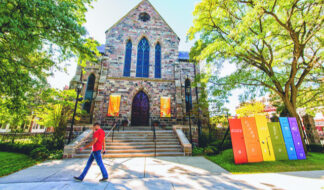By Anton Anderssen
Love is an art, and art is a love. When the two are intertwined, magic happens. Capturing emotion and transfixing it into tangible form requires genius, and such objets du desir are rare indeed.
Now appearing at the Detroit Institute of Arts is "Monet to Dali: Modern Masters from the Cleveland Museum of Art," an amazing collection of Impressionist, Post-Impressionist and Avante-Garde paintings, complemented by Early Modernist sculpture.
These works are by some of the world's most beloved artists, and together they tell the fascinating story of the European Modernism development from the mid-19th century to the mid-20th century. These are the peoples' artists – they hold the secrets that reconcile us with life and with our own humanity.
Recall your early childhood, your first visit to a cider mill. Remember the sweet aroma of apples and the bountiful harvest, the joy of being a child? Pierre-Auguste Renoir's "The Apple Seller" illuminates and transforms time and place, moods and emotions back to a simple and beautiful era of wholesome abundance.
Renoir captures the ideals of nature with sparkling color and light, focusing more on the essence of the subject rather than details. He is perhaps the most loved of all the Impressionist painters due to his choice of subjects – adorable children, cascades of flowers, stunning colors and ravishingly beautiful women. Renoir once wrote "Why shouldn't art be pretty? There are enough unpleasant things in the world."
Unlike their predecessors, the Impressionists used bright and radiant colors, eschewing the use of earth and dark colors; they could see what none before them could see – that shadows are not black.
"Everyone discusses my art and pretends to understand, as if it were necessary to understand, when it is simply necessary to love," said Claude Monet, whose works grace this magnificent collection five times. His personal favorite, the one he kept by his side until his death in 1926, is "The Red Kerchief: Portrait of Mrs. Monet." The love of his life, Camille, is seen through glass panes on the veranda on a cold, wintry day. Monet captures an instant, somewhere in time, as his wife glances briefly at the artist, enrobed in a bright red cape, centered before the backdrop of a snow-laden landscape.
Pablo Picasso painted "Woman with a Cape" at the callow age of 19; this delightful portrait reflects his early years when his artistic style was quite similar to Renoir and Monet, long before his blue, rose and Cubist periods.
Picasso's "Harlequin with Violin" combines the black hat, domino mask and diamond-patterned costume of Harlequin, with the white conical hat of Pierrot (both are stock characters from the Italian Theatre, Commedia dell'Arte). Picasso repeatedly portrayed himself as Harlequin, a mischievous character notable for impetuousity and resourcefulness. Indeed, Picasso's endless affairs garnered him much notoriety. But Pierrot, the sensitive one, always suffered unrequited love. A most revealing clue to the painting's key hermeneutics is the phrase "Si tu veux," written atop a sheet of music, which refers to a popular song that begins: "Si tu veux faire mon bonheur Marguerite donne-moi ton coeur" (If you want to make my happiness, Marguerite, give me your heart).
I have many favorites in this spectacular exhibit, but the one that calls out to me is Festival of Flowers (Fete des fleurs), by Henri Matisse. Matisse moved to the French Riviera in 1917, where he adopted a relaxed and tranquil life surrounded by balmy breezes and ever-blooming flowers, soaking up the golden sun and rejoicing in its dancing lights reflecting from the azure sea. "Fete des fleurs" depicts the view from Matisse's balcony in the Hotel de la Mediterranee overlooking the Promenade des Anglais in Nice. Matisse's daughter Marguerite prepares to toss flowers to the participants in the parade below. In the background, foothills of Mont Alban slope gracefully to the sea. I know this scene so well – my husband took me on a romantic visit to Provence, where we sat on the balcony of the Hotel Le Meridien, overlooking the Promenade, and listened to gentle waves lapping the beach, looking eastwardly toward Mont Alban. Matisse captures the beauty and romance of this Provencal Eden so well that I could almost smell the fragrance of jasmine in the air.
Monet to Dali features works from nearly every major European artist – Cezanne, Dali, Gauguin, Matisse, Monet, Picasso and Renoir are just a few of the artists represented here. An entire room showcases sculptures wrought by Rodin and his contemporaries. The exhibit, sponsored by Bank of America, runs through Jan. 18, 2009.









